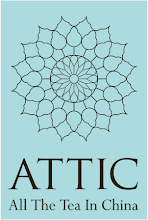
Probably the most commonly known of Chinese teas, the sweet and refreshing taste of Jasmine teas have proved popular in the Western world. Most people are likely to have enjoyed a cup at some point in their lives, whether it was following some delicious Dim Sum, enjoyed at home with the Sunday paper and of course here at ATTIC, where the Jasmine Teaball still remains our best seller.
However, it would be a great injustice to interpret Jasmine’s prevalence for it being an ‘ordinary’ tea. In fact, if it wasn’t for the Ming Dynasty (1368 – 1644) scented teas would still only be a luxury that emperors and noblemen could afford. Prior to this, teas were scented with pure essential oils, which were extremely expensive. The Ming Dynasty, thanks to its obsession with all things floral, started to use flowers as a cheaper method to scent teas, enabling a greater number of people to enjoy their sweet, delicate flavour.

At ATTIC, we offer two Jasmine scented teas: our visually stunning Jasmine Teaball and our ‘Tea of the Week’, Jasmine Phoenix Pearls.
Often overshadowed by the spectacular visual theatrics of the Teaball, the Jasmine Pearl is very much a butterfly under the guise of a moth.
Underneath its humble appearance, lies a peerless beauty in fragrance and taste. The metamorphosis from green tea to jasmine pearl, should be noted, is of equal splendour.
The finest teas are produced by using green tea leaves harvested “before-the-rains” (early April to late May) which are then steamed to improve the absorbency of the leaves ready for the scenting process. The leaves are then stored until August, when the jasmine flowers come into bloom. The flowers are picked at around midday, when they are still tightly closed, and as the temperature begins to cool in the evening they begin to burst open (some claim to even hear a faint popping sound when this occurs!) and the scenting process can begin. Using twice as much jasmine to tea, the two components are mixed together, with the heat and humidity carefully regulated. This is usually repeated two or three times, but the finest Jasmine teas are the result of five or six repetitions, using fresh flowers each time. The tea is then re-fired to remove the moisture from the flowers, which can lead to moulding. On occasion, the odd dried flower can be found amongst the tea, adding a charming reminder of this long but loving process.
Due to its lengthy process, many commercial jasmine teas are often sprayed with scent, but it is this labour-of-love production that makes real Jasmine tea an almost artisan product. Jasmine Pearls are even more limited in their production, as the fired leaves are then skilfully hand-rolled into little ‘pearls’ of tea that “unfurl to release clouds of perfume in your cup”. None of us here at ATTIC can resist a sniff of the steamy scent released by the remaining leaves in our tea-makers!
Due to its intensity of scent, it can also be re-flushed several times without losing too much flavour, and one initial serving has been known to keep us supplied with tea all day!
So, please make our new batch of pearls feel welcome by giving them and let them reward you with their sweet, uplifting taste!





No comments:
Post a Comment